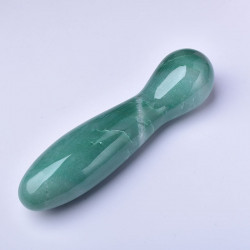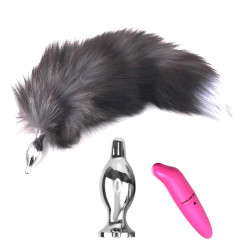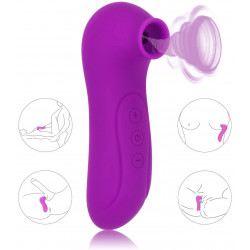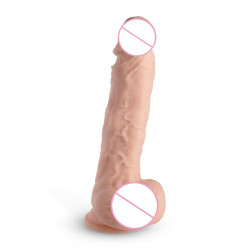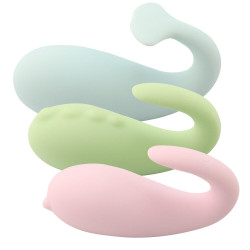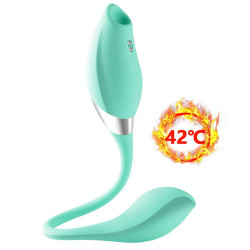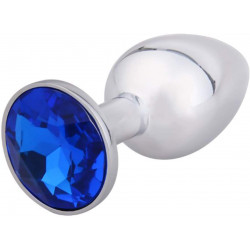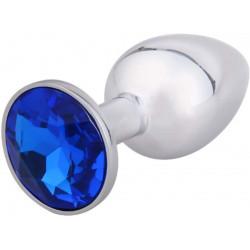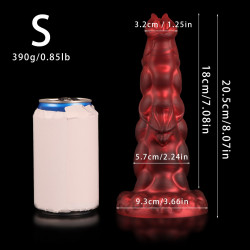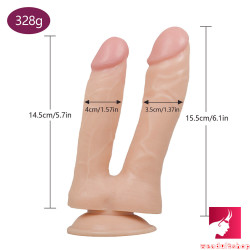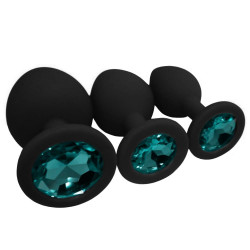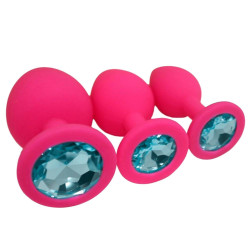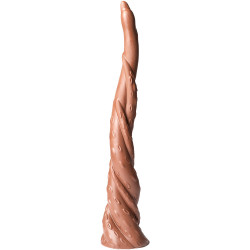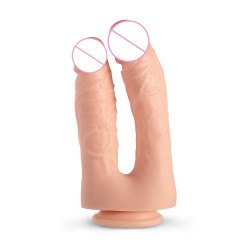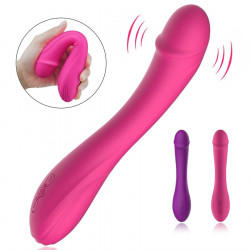Sex Toys 101: A Guide to Body-Safe Materials
You want to make sure that toys are made of high-quality, body-safe materials if you want to put them on or into your body, right? The issue is that sex toy research isn't always easy, and manufacturers don't often make crucial information obvious on their packaging. Later, more on that. Furthermore, toys can be made from various materials, including rubber, silicone, metal, and glass. When it comes to sex toys, you might be asking why material safety matters, what materials are safe, and how even to start sorting through all the clutter.
We've demystified the various materials frequently found in sex toys here, and we'll go into more detail to discuss why buying high-quality, body-safe toys is crucial.
Why is Material Safety Important When It Comes to Sex Toys?
The sex toy sector is not currently subject to government regulation, in contrast to the food production or medical device industries. In essence, sex toy firms are in charge of upholding the honor system for their products because it's an unregulated industry that doesn't follow any particular rules. Customers must be able to trust the toy firm and have faith in their suppliers and the ingredients used in their products. This involves businesses being extremely open and honest about the ingredients in their goods.
The issue with an uncontrolled business is that, in an effort to save money, some ingredients that are toxic or are strongly suspected of being harmful may nevertheless find their way into your sex toys. Additionally, since no one requires brands to reveal material information, harmful elements may be concealed in their goods. Considering where you're naturally placing sex toys—your mouth, anus, genitalia, etc.—this is especially crucial. Compared to the rest of your skin, the mucous membranes that make up these parts of your body are more permeable.
In other words, they can absorb hazardous substances and liquids.
Let's now discuss those compounds. Phthalates are one of the most significant additives in toys, and you should stay away from them. One kind of plasticizer—an additive that increases the malleability of solid materials—is phthalates. To put it another way, toys are flexible because of plasticizers. (Note: not all plasticizers are phthalates, even if phthalates are plasticizers.)
However, the issue with phthalates is that they readily leach out chemicals. Leaching is quite problematic because this toy will come into contact with your most sensitive areas, mainly because certain phthalates are believed to be carcinogenic (i.e., to cause cancer) or detrimental to reproduction.
You may generally feel secure because the most respectable companies don't utilize phthalates to produce their toys. Just be sure to explicitly state in their description that their items are "phthalate-free" or "made without phthalates." If in doubt, look for another brand and assume that phthalates are utilized. Your sexual well-being and health are too vital.
So, What Materials in Sex Toys Are Body-Safe?
After discussing the risks posed by phthalates, let's discuss common materials. It's crucial first to examine the two primary characteristics of sex toys—porosity and inertness—to gain a better understanding of the materials used in toys and, consequently, their safety.
Porosity
Both porous and non-porous sex toys are available. A sponge is most likely the first object that comes to mind when you think of anything as porous. A kitchen sponge is perfect for absorbing water but may also absorb and retain other materials, such as food particles and bacteria. A porous sex toy, like a sponge, may house bacteria that cause or spread illnesses. A non-porous toy that is simple to clean after each usage is what you want to look for when buying one.
Inert
The quality of a material being non-reactive, or not changing over time, is known as "inertness." If you wash and care for your toys properly, inert materials won't harbor bacteria or leak chemicals onto your skin.
Inertness plus non-porousness equals a high-quality sex toy.
Standard Materials for Sex Toys
Silicone
If you've started looking into sex toys, you may have found that a lot of them are constructed of silicone. The inert substance silica is the main component of silicone rubber, an elastomer. Silicone is likewise utilized in food-grade products because toxins from our kitchenware mustn't seep into our food. Medical devices are another common application for silicone. Silicone is created into a unique kind known as "medical-grade" silicone when utilized in medical equipment and injected into the body.
It's crucial to understand that not all silicones are inherently non-porous and of medical quality, even though silicone is generally safe for use in sex toys. That is how they must be intentionally made. Furthermore, it is crucial to buy from reliable brands because corporations can add coloring or other ingredients to a product, rendering a toy no longer inert. Since it is the only kind of silicone proven to interact with human bodies, many manufacturers are now choosing to employ medical-grade silicone. Since this kind of silicone is more costly, the pricing usually reflects that.
Study in advance to ensure you know what kind of silicone you purchase, as with everything else. Our tagline at Adutoys is "non-porous silicone and phthalate-free; That's what I like inside of me!" about our toys.
Think about these silicone toys that are non-porous and devoid of phthalates: Blush's Avant D10 Ergo Mini 6.5" Silicone Suction Cup Dildo or Resistant Silicone Dildo.
Glass
Glass is a safe material for intercourse since it is non-porous, inert, and easily cleaned. All you need to do is make sure the toy is sufficiently strong and that you're cleaning it correctly after every use. Glass toys have the added fun feature of being able to be heated or chilled to enhance sensations while playing.
Want to experiment with glass play? Try the Pipedream Icicles No. 57, a sophisticated and artisanal glass toy.
ABS Plastic
One kind of strong, non-porous plastic is ABS. These toys are often smooth, safe for the body, and easy to clean. Although ABS is usually far less expensive than silicone, silicone toys tend to feel more upscale. You're safe because most plastics don't contain phthalates, but if you're unsure, always ask the manufacturer.
Examine these body-safe ABS Noje Pleasure Wands from Blush.
Metal
Familiar metal toys made of aluminum and stainless steel are smooth, streamlined, and rather heavy. Metals vary in grades, but these are also non-porous, inert materials. A toy should not be utilized if it exhibits even the slightest hint of possible rust.
Like glass, metals are easily cleaned and excellent for temperature play.
With this XR brands Master Series Metal Anal Plug, go deep.
Wood & Stone
Although they are less popular than the others, non-porous toys made of natural materials like stone and wood are available. These toys frequently have a smooth, elegant shape and are occasionally treated to render them non-porous. Wood and stone toys are more likely to be high-end (and pricey) novelty toys than your typical daily toys.
TPR, TPE and PVC
Isn't that a large number of acronyms? Let's dissect these.
Porous toys usually contain polyvinyl chloride (PVC), thermoplastic rubber (TPR), and thermoplastic elastomer (TPE). Jelly-like rubber is another substance that frequently contains phthalates and falls within the porous category. These goods are porous, which means that even after washing, dirt and bacteria may be trapped by tiny holes. Once this bacterium comes into contact with the previously described fragile mucous membranes, it can cause illnesses.
Toys that contain these materials should be avoided, but if you insist on using a toy you genuinely love, cover it with a condom for protection.
Quick Tips for Toy Safety and Sexual Wellness
Think of the following as red flags regarding your toys:
- A chemical reaction may occur if you observe discoloration or changes in the toy's composition.
- Your toy may be hiding something foul and should not be used if it begins to smell, even after you have cleaned it. However, remember that premium silicone may initially smell a little like it was manufactured, but this should quickly disappear.
- Your toy isn't inert; therefore, you shouldn't put it on your nether regions if it suddenly starts to form a slippery coating. This could be an indication that the plasticizers are breaking down.
- A toy's low price point could indicate that it was constructed with subpar materials. Medical-grade silicone is costly to produce and therefore has a hefty price tag.
- Avoid a product or manufacturer if you can't find much information. Reputable, superior companies list their resources as approachable, easily comprehensible, and stand behind their products. Reputable companies like Womanizer, Dame, and We-Vibe are excellent starting places.
Let's recap:
Using safe toys for your body is crucial, regardless of whether you're bringing a toy into the bedroom for the first time or even doubting some of your past purchases. In addition to being built of non-porous and inert materials, toys must be properly cleaned and maintained.
Always buy from a reliable manufacturer because sexual wellness is as vital as other parts of your health, if not more so. After all, it's your health, so ask questions when unsure.
Enjoy your shopping!



